2018 Annual Report
Jasper National Park
Parks Canada is pleased to present highlights of our work in support of all areas of our mandate in Jasper National Park for 2018. This report complements our annual public forum to provide an update on implementing the Jasper National Park 2010 Management Plan.
Download the 2018 Annual Report as a PDF (1.5 MB)
Welcoming visitors to mountains of opportunity
Winter highlights
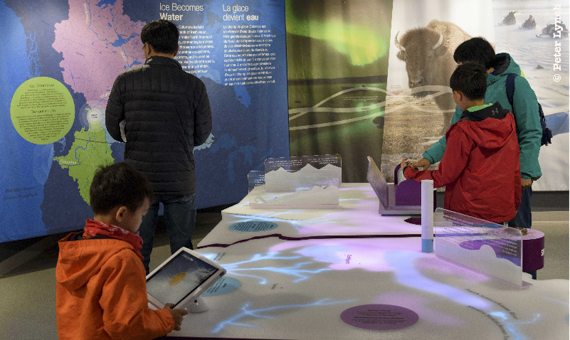
© Parks Canada / P. Lynch
Whirlpool Winter Hub was a popular basecamp for adventure, offering nearly 20 km of groomed cross-country ski trails. On the Whirlpool Trail, skiers could extend their trip on the new 800 m of groomed trail to a viewpoint over Moab Lake or take a break on the Red Chairs at the halfway point. The Leach Lake Trail also featured a rest stop picnic table at the lake, and new confidence markers to help with navigation and motivation. Winter camping at the Hub began December 15.
Pyramid Lake continues to be a well-loved winter hub with groomers successfully piloting two new multi-use loops on the lake. Cross country skiers, fat tire bikers, snowshoers and walkers enjoyed panoramic views from groomed and flat-packed tracks in the middle of the lake. Along Pyramid Fire Road, new confidence markers helped users determine the distance best for them.
Snowshoe learning activities at both hubs during Jasper in January and the Family Day weekend allowed visitors to master this increasingly popular sport, while delving deeper into the world of dark skies, mountain pine beetle and wildlife.
Glacier Gallery opening
Spring 2018 welcomed a new Parks Canada exhibit gallery into the lower floor of the Columbia Icefield Visitor Centre. The newly constructed Glacier Gallery uses a mixture of low-maintenance interactive exhibits and sign content to provide visitors with interpretation focused on glacier science, the importance of water systems, and climate change. Additionally, new signage was installed on the Toe of the Glacier trail and old/damaged signage was removed and repaired. The result is a significant improvement on the condition and quality of interpretive assets at the Columbia Icefield Visitor Centre.
Infrastructure investment
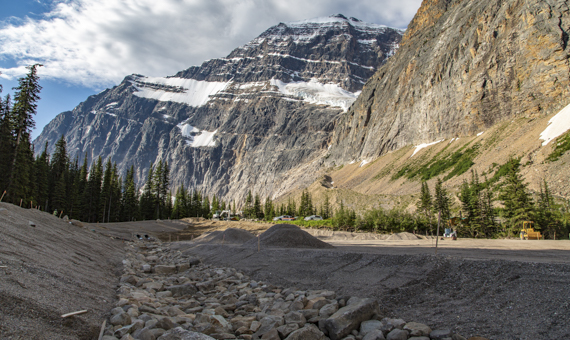
© Parks Canada / S. Potter
In 2018, Parks Canada entered the fourth year of a five-year $3 billion national infrastructure renewal program. $270 million has been allocated to rehabilitate roads, highways, visitor facilities and critical infrastructure in Jasper National Park.
Park roadways
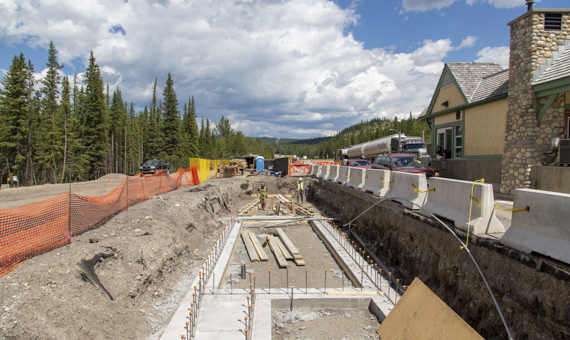
© Parks Canada / S. Potter
In 2018, Parks Canada invested $43 million in projects on Highways 16 and 93N, and other roads in Jasper National Park, to improve user safety. Highlights of major work in progress or completed:
- The East Gate approach;
- Paving on the Icefields Parkway, Highway 93A, and Pyramid Lake, Marmot Basin, Whistler Mountain and Maintenance Compound roads;
- Highway 16 intersections; and,
- Meadow Creek Bridge construction on Highway 16.
Miette Hot Springs
Work has been completed for a $6 million investment in the sewage treatment plant. Using the best available technology, renovations were targeted to reduce single points of failure that could cause closures. As a major part of the work, a second rotating bacteriological cylinder was installed to create redundancy in the system should one stop working. The cylinder came by road from Québec, and was put into place using a large crane. The plant is operational and commissioning will be completed in summer 2019.
Trails and backcountry camping
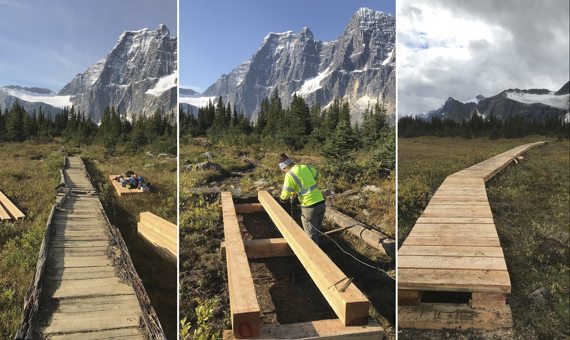
© Parks Canada / A. McNutt
Overall backcountry camping use from April 1 to October 31 experienced a 16% reduction in visitation compared to 2017. Contributing factors included a spike in 2017 due to free admission for Canada 150, a 45% decline in visitors to the Tonquin Valley due to the Astoria Trailhead being inaccessible, smoky August skies from forest fires, and later than usual opening of the Skyline Trail and North Boundary campgrounds. Popular locations such as Maligne Lake and the Skyline Trail remain in high demand. Alternative offers like Jacques Lake and Fryatt Valley saw usage increased by 10%.
Outside of regular maintenance and reactive management, trail crew efforts were focused in the Tonquin Valley and on the Mary Schäffer Trail this year. As part of a three-year plan to improve conditions, in the Tonquin Valley:
- 13 bridges were reconstructed,
- 110 m of boardwalk replaced,
- 6 campgrounds maintained,
- 600 m of trail brushed, and
- 120 m of tread repaired.
The Mary Schäffer Trail, along the shores of Maligne Lake, saw substantial improvements to the tread (700 m), the viewpoint and directional signs. This popular trail now provides easy access for all levels of trail users.
Parks Canada volunteers
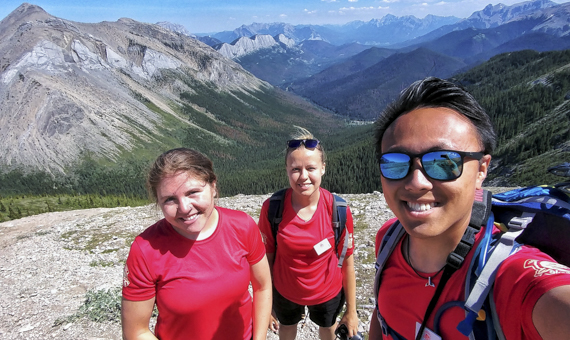
© Parks Canada / D. Wong
More than 250 people volunteered more than 3,000 hours for Jasper National Park. Projects ranged from ecological monitoring to cultural resource assistance. Thirty volunteers participated at interpretive programs and events, and on park trails, through a new program, the Jasper Park Stewards. 77% of volunteers reported being “very satisfied” with their summer time experiences and the support they received from Parks Canada.
Interpretation programs
Jasper National Park's interpretive programs were attended by over 90,000 visitors in 2018. Parks Canada delivered over 623 programs at Whistler Theatre, the Jasper Heritage Firehall, on roves and at campfires. Summer exhibits and programs at the firehall focused on species at risk, mountain pine beetle and wildlife watching etiquette. A new species at risk program focused on bats was launched in the fall. The Jasper Heritage Firehall, spring and fall roves and Wildlife Guardians continue to enable interpreters to capture a diverse audience and communicate important stewardship and wildlife messaging.
Overall park visitation and campground use
Attendance levelled off for the first time in eight years; slight 0.4% drop in 2018 and 3% fewer camping permits issued. Note 2017 spike due to Canada 150 free entry. +200,000 visitors served at the Jasper Information Centre.
| 2014 | 2015 | 2016 | 2017 | 2018 (projected) | |
|---|---|---|---|---|---|
| Attendance | 2,154,710 | 2,258,830 | 2,354,809 | 2,425,218 | 2,415,228 |
| 2014 | 2015 | 2016 | 2017 | 2018 (projected) | |
|---|---|---|---|---|---|
| Camping | 148,483 | 166,381 | 176,735 | 199,550 | 193,625 |
Bringing mountains to people where they live
Outreach and promotions

© Parks Canada / K. Weir
Jasper National Park's promotions and urban outreach programs connected with more than 8,000 people in the Edmonton area in 2018, supported by relationships with Telus World of Science, Edmonton Valley Zoo, John Janzen Nature Centre, Muttart Conservatory and Fort Edmonton Park.
The Parks Canada “What’s the Connection” exhibit racked up 60,000 exposures in Edmonton, Vancouver, Vernon and Calgary.
Reaching Canadians and international visitors
The Jasper National Park website remained the leading tool for visitors planning to visit our park with just over 1.9 million unique page views in 2018. The website’s functionality, navigation, and layout continued to be improved to respond to visitors’ needs.
Engagement through social media channels continued to grow at a steady rate: a 16.5% increase on Twitter to 23,700 followers and a 16.8% increase on Facebook to 42,000 fans. Direct messaging on social media saw a significant increase with over 2,000 direct contacts on Facebook and Twitter.
Partnering highlights
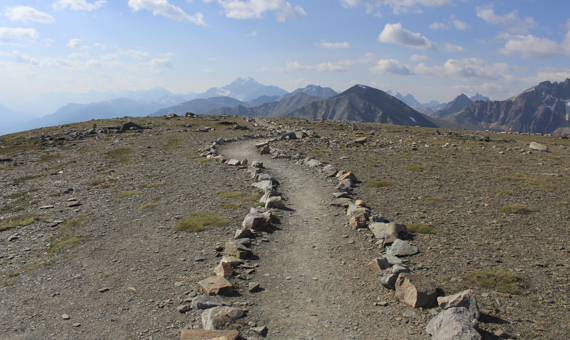
© Parks Canada / K. Gedling
The Whistlers Mountain summit restoration partnering agreement was extended for one year into spring of 2019. The majority of Friends of Jasper volunteer trail work has now been completed, with the project entering the interpretive planning phase now.
Education programs
In partnership with the Grande Yellowhead Public School Division, the Palisades Stewardship Education Centre welcomed youth from across Alberta and British Columbia for a range of environmental programs. Five buildings were opened to the public through the Parks Canada Reservation Service in January 2018. Revenue from public accommodation rentals supports the education programs.
The Education Team delivered programs to more than 2,100 students from 85 different groups. The Marmot Learning Centre, in its new mid-mountain location at Marmot Basin Ski Area, hosted over 800 students.
Celebrating history, culture and the World Heritage Site
Protecting cultural resources
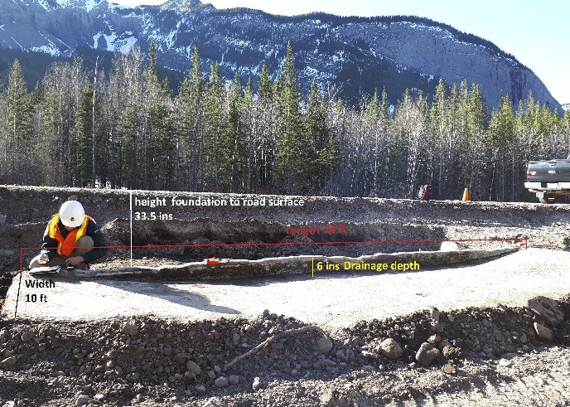
An incidental find is anything that is identified as a potential historical or pre-contact item that was noticed during work in an area, excavation or a building that could have significant historic potential. This year, incidental finds were evaluated at various locations at major construction projects throughout the Park. This included foundations to the old East Gate during road construction and ranged to culturally modified trees and can dumps along the Canadian National Railway during Firesmart forest fuel reduction projects. In turn, these were recorded and evaluated for cultural or archaeological value.
Various highway related projects such as passing lanes and rock scaling were photographed to provide a “before” picture of major projects. “After” pictures are then taken to show what changes have occurred on the landscape.
Ensuring healthy ecosystems
Southern mountain caribou
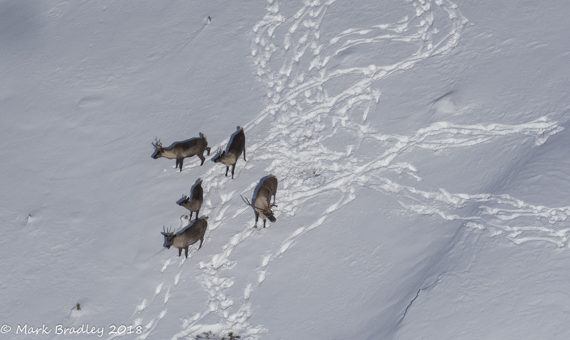
© Parks Canada / M. Bradley
Monitoring suggests that caribou herd numbers are stable, but very low with the three southern herds likely to become eventually extirpated without augmentation. Through the results of DNA analyses and visual surveys, the Tonquin herd is estimated at 31 animals, and the Brazeau and Maligne herds at ten or less. We continue to work with the Government of Alberta to monitor the À La Peche herd, estimated at 140 individuals, which lives on both sides of the park’s north boundary.
Wolf density is presently low in Jasper National Park, indicating that conditions for caribou survival and recovery are improving. We continue to research the feasibility of conducting captive breeding for caribou recovery, and continue to monitor ecological conditions in caribou habitat.
Bird species at risk
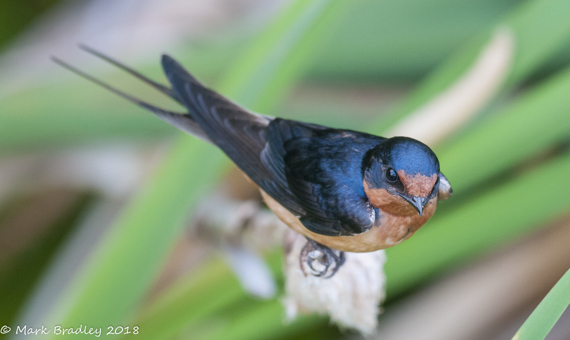
© Parks Canada / M. Bradley
The multi-species action plan for Jasper National Park identifies the importance of finding nesting and breeding sites of two threatened birds: common nighthawk and olive-sided flycatcher. Breeding behavior was not detected when common nighthawk habitat was inventoried, suggesting that nesting remains a rare occurrence and that they are likely a more transient species within the Park. Olive-sided flycatcher observations indicate this species continues to breed in the Park. This species prefers post-fire habitat, so prescribed fire plans target improving habitat for this species.
In 2018, barn and bank swallows were added to the Species at Risk Act as threatened species and park staff completed baseline surveys of nesting habitat for these species. Our work identified 59 active barn swallow nests and 26 active bank swallow colonies in the Park. We created distribution maps to support future protection and restoration activities.
Black swifts were recently assessed as Endangered in Canada by the Committee on the Status of Endangered Wildlife in Canada. Surveys of black swifts highlighted sites in the Maligne Valley as their preferred breeding grounds, and estimated a minimal population size of 12 to 14 reproductive adults in the Park. New breeding sites have been identified and distribution maps were created to support conservation.
Human-wildlife conflict

© Parks Canada / M. Bradley
Human-wildlife conflict is both a visitor experience and visitor safety issue, and can also impact wildlife populations in Jasper National Park. Viewing wildlife is the main goal of many visitors, and activities like climbing, biking or hiking can bring visitors close to wildlife. Effective human-wildlife conflict management practices supports positive experiences while reducing the frequency and severity of negative encounters. In 2018, human-wildlife conflict staff responded to 2,185 incidents, of which 223 had human safety concerns.
Bull trout survey
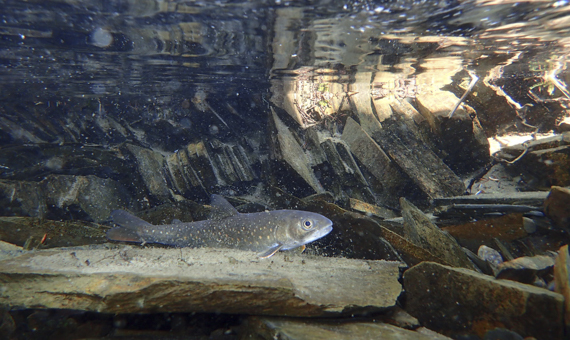
© R. Sowers
Bull trout is disappearing from much of its historic range in the province because of factors such as overharvesting, habitat degradation, introduction of non-native fish, and climate change. It is considered Threatened in the Province of Alberta, and the Committee on the Status of Endangered Wildlife in Canada has recommended it as a species of Special Concern under the Species at Risk Act. Protected high-elevation watersheds inside Jasper National Park represent an important refuge for bull trout. Aquatic staff from Jasper National Park teamed up with biologists from Alberta Environment and Parks to undertake the first ever comprehensive electrofishing survey of the Upper Miette River and Derr Creek.
The team found that bull trout were widely distributed and abundant throughout the river systems, except where they have been excluded by impassable terrain. That’s good news for bull trout. Protection inside the national park has ensured the maintenance of a healthy population. The province plans to use the results as a baseline reference for bull trout population management throughout the province.
Mountain pine beetle management
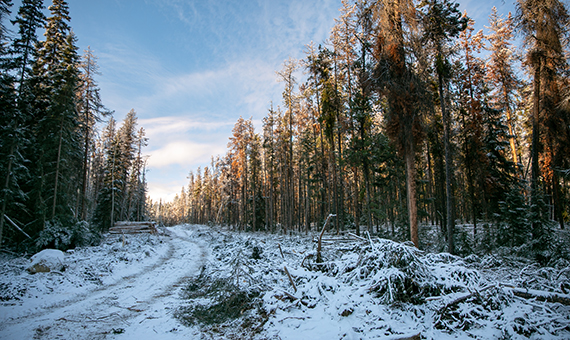
© Parks Canada / D. McDonald
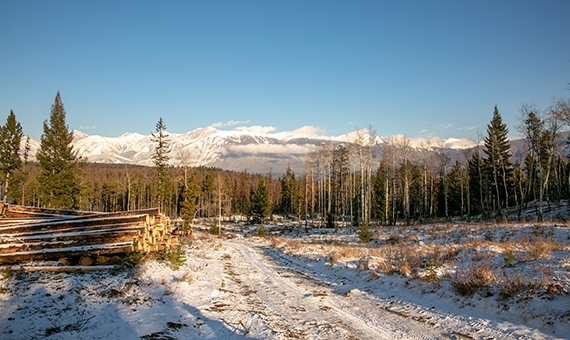
© Parks Canada / D. McDonald
In partnership with the Canadian Forest Service and Alberta Agriculture and Forestry, we conduct annual aerial surveys to estimate mountain pine beetle population distribution and abundance as well as mountain pine beetle population infection levels.
We are focused on addressing the impacts of the beetle – removing trees from around town to reduce wildfire risk, removing hazardous trees from campgrounds, and protecting the endangered whitebark pine from attack.
In the fall of 2018, Parks Canada and forestry company Canfor began work to reduce the amount of dead and dying trees in mountain pine beetle affected forest west of the Municipality of Jasper. This forest fuel reduction project will add to previous fuel reductions on Pyramid Bench and will make future prescribed fires less complex, safer and more efficient.
Wildfire preparedness
In 2018, fires in British Columbia burned record-setting areas of forest and drifting smoke led to several air quality warnings in Jasper National Park. Parks Canada and the Municipality of Jasper hosted multiple public presentations to inform residents about how we work and train together to prepare in the event of a wildfire near town.
There were no significant wildfires in the park this year. A fire ban was in place for six weeks from May to July and a helicopter and fire crew were on standby for 65 days during high to extreme fire danger conditions. The fire crew attended to 20 illegal campfires and quickly extinguished small lightning caused fires at Wabasso Lake and Portal Creek.
Strengthening relationships with Indigenous peoples
Reflecting on our relationship with Indigenous partners
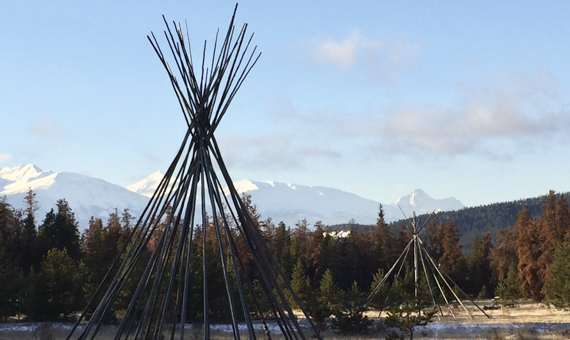
As part of the 2018 State of the Park Assessment, 15 representatives from nine Indigenous communities rated indicators of the Park’s work with Indigenous communities over the last 10 years. This exercise allowed partners and Park staff to identify strengths and challenges, to track progress, and to reflect on areas where we should focus our efforts.
We received a mix of ‘fair’ and ‘poor’ ratings. Highlighted successes included development of the Cultural Use Area, the reintroduction of ceremony in park operations, the recent Simpcw First Nation traditional harvest, and the Jasper Indigenous Forum. Areas for improvement included the need for more concrete Indigenous presence in the park, more economic opportunities for Indigenous partners, and incorporation of traditional knowledge in the management and presentation of the park. The assessment showed there is room for improvement in many areas, but Parks Canada is headed in the right direction.
Indigenous working groups

The Jasper Indigenous Forum brings together park managers and over 20 Indigenous groups with an historical connection to the park on a bi-annual basis. The park also engages more frequently with Indigenous partners through a number of working groups, providing guidance on specific, short-term projects or activities, and advisory groups, providing guidance on long-term, strategic areas of Park operations.
Increasing local connections in Indigenous interpretation
In 2018, Jasper National Park’s Indigenous interpretation program initiated an elder mentoring program, which brought local Indigenous knowledge holders to the park to share some of their traditional knowledge about Jasper National Park with the park’s Indigenous interpreters. An Indigenous interpretation advisory group has also been established to help the park further develop its Indigenous interpretation offerings to the public.
Fostering open management and innovation
State of the park
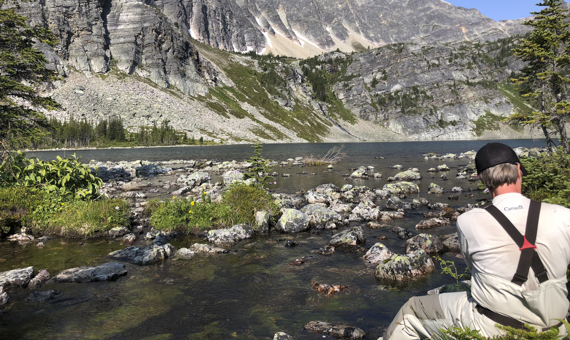
The State of the park assessment uses data from a variety of sources in a standardized approach, allowing Parks Canada to compare parks and sites across the Parks Canada network. Results for Jasper National Park are provided across six main themes: ecological integrity, cultural resources, visitor experience, Indigenous relations, external relations and built assets.
Financial summary
In fiscal year 2017-18, the Jasper Field Unit, comprised of Jasper National Park and Fort St. James National Historic Site in British Columbia, operated on an approximate budget of twenty-five million dollars. Funding was achieved through revenue generated within Jasper Field Unit, primarily entry fees, campground fees, and land rents. In 2017-18, financial assistance was also received from the Government of Canada through the Canada150 free entry initiative. 55% of the budget was allocated to staff salaries, 25% to operations, and 20% to capital investments.
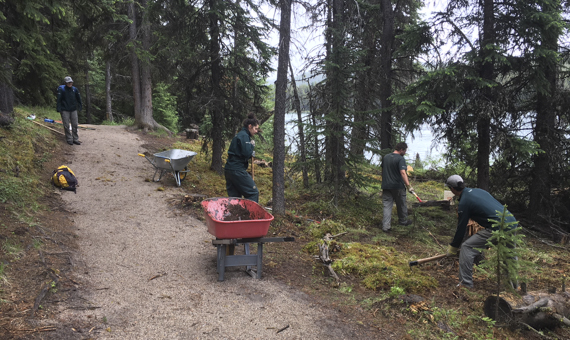
Additionally, the field unit received approximately forty-three million in special funding for projects related to wildfire management, conservation and restoration, and investment in assets including trails, campgrounds, roads and bridges.
Managing growth and development
Community development in the Municipality of Jasper

© Parks Canada / M. Bradley
36 additional residential units began or completed construction in the Town of Jasper in 2018. This includes 21 row housing units at Aspen Gardens, expected to be ready for occupancy in the spring of 2019, and 7 staff accommodation units for the new in-town Hostelling International property, with bedrooms for 14 staff.
We continue to work closely with the Municipality of Jasper, meeting regularly to discuss items of mutual interest. Key topics in 2018 included fire smart and fuel reduction in and around town, the legalization of cannabis, and a variety of projects aimed at increasing the housing supply in town.
We also continue to collaborate with the Jasper Community Housing Corporation on housing initiatives to provide more rental and leased units in town while respecting the legislated boundary.
| Commercial Floor Area (CFA) Cap 2001 | 9,290 m2 | 100% |
|---|---|---|
| Developed CFA | 4,560 m2 | 49% |
| CFA Not Developed, but Allocated | 3,355 m2 | 36% |
| C1/C2/C3/C4 CFA available for Allocation | 1,374 m2 | 15% |
| S Block CFA available for Allocation | 0 m2 | 0% |
In 2018, Parks Canada issued permits for 5 new restaurants and 4 cannabis retailers. In total, Parks Canada issued a total of 117 development permits and 28 building permits in the Town of Jasper.
ATCO Electric Transmission Line
Parks Canada approved the ATCO Electric Jasper Interconnection Project in June 2018 after completing a detailed environmental impact analysis process and considering consultation. The project will connect Jasper National Park to Alberta’s electrical system by constructing a 45 km electrical transmission line along existing utility and transportation corridors. This will replace the existing natural gas and diesel electrical generation facility near Jasper townsite, which is close to the end of its life expectancy.
Parks Canada’s approval was subject to conditions requiring ATCO Electric to implement measures to protect natural and cultural resources, and an environmental restoration program with annual reporting.
ATCO Electric began construction in September 2018 and the transmission line is expected to be in service in May 2019.
Proposed Icefields Trail (North)

©R. Gruys
Budget 2016 provided $65.9 million in funding to Parks Canada for a new biking and walking trail in Jasper National Park. Preliminary feedback from the consultation process expressed concerns over the potential environmental impact and high cost associated with the project. For these reasons, Parks Canada has decided to withdraw from the Icefields Trail project and will reallocate the funds to priority areas within the Agency.
- Date modified :